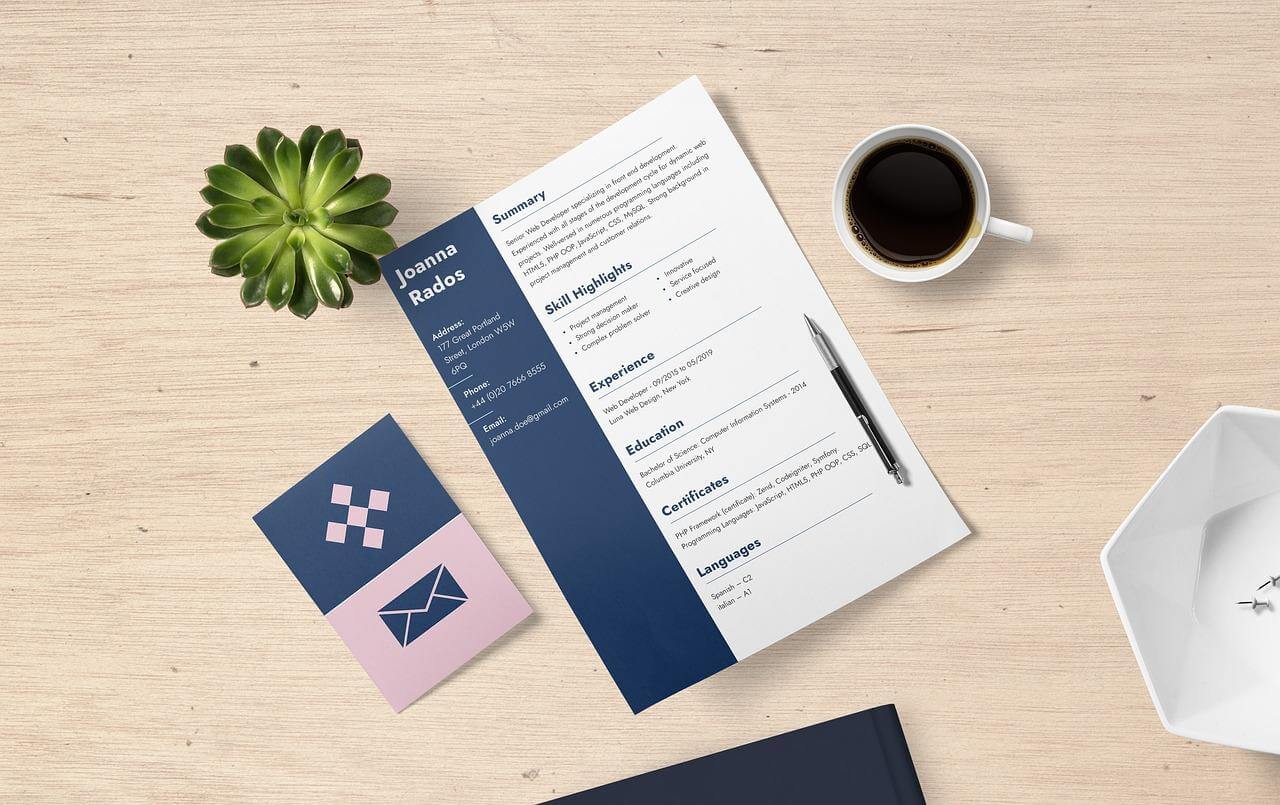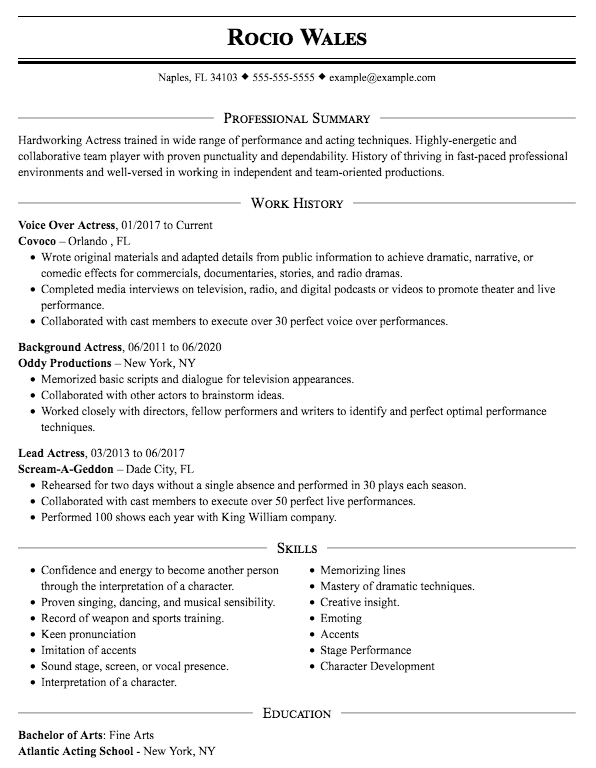Reverse Chronological Resume Format: Guide & Best Practices

Image: https://pixabay.com/photos/resume-cv-job-application-career-6627200/
With years of experience writing and evaluating resumes, I’ve noticed that hiring managers prefer clear, easy-to-scan timelines of career growth. The reverse chronological resume delivers exactly that - if you know how to structure it right. This format is the most common in the world. Recruiters and employers also prefer it, as this format allows them to grasp the candidate's career history, achievements, and job tenures in seconds.
In this article, you will learn more about this format, how to write it, and when to use it. Plus, we will share professional secrets to writing resumes that capture attention and stand out in a crowded job market.
Want a professional resume that positions you best for the job search? Turn to our experts. At ResumePerk, we prepare competitive resumes for every industry and career level. We will craft a result-oriented, informative resume that helps distinguish you from other job-seekers. Place your first order with a special welcome discount!
What Is a Reverse Chronological Resume?
This type of resume is written in a format that lists your work experience starting with the most recent job and moving backward in time. How to define reverse chronological order? You just need to start with the most recent job. This format is required for the majority of job postings. Thus, reverse chronological order means listing your latest job or event first, followed by earlier ones. That is it!
What is a reverse chronological order resume? You start with education and skills. Next move to employment history, and finally provide information about certifications, training, and other data you want to share about yourself with your potential employer!
This resume format presents your career starting with the most recent position and goes backward. Your degrees, internships, and projects are listed in the same way. It puts your career progression into the spotlight, emphasizing company names, titles, and tenures.
Thus, this resume format gives your most recent jobs the maximum exposure and minimizes the roles you had 10 or 15 years ago. Since employers are mostly interested in your recent experience, a chronological format is the best for a variety of career levels and industries.
Why Use This Format?
If you wonder whether your resume should be chronological, review the following benefits of preferring this format.
- Shows career progression clearly - Employers can easily track your growth and promotions over time due to the resume showing steady career growth.
- Highlights recent experience - Puts your most relevant and up-to-date roles at the top. It is the best resume format to highlight recent experience.
- Preferred by recruiters and ATS - It's the most widely accepted format, making it easier to scan and parse.
- Demonstrates work stability - A consistent work history builds trust and credibility. A job-winning reverse chronological resume secures more interviews!
- Easy to read and organize - The logical timeline format helps recruiters quickly understand your background.
The chronological format became the most common for a reason. Here are the benefits of formatting your resume in a standard professional format:
Emphasize relevant experience
In the chronological document, your recent experience is placed near the top of the document. Thus, recruiters can quickly scan through job titles, responsibilities, and achievements to ensure that you are a great candidate for the job.
Highlight career growth
For mid-career professionals and managers, a chronological format helps emphasize steady career growth. Thus, the hiring managers can observe your growth in responsibility and job titles. They will see how your skills and job duties increased over time, thus helping create a great professional image.
Spotlight the longevity
Most employers prefer candidates who stay with the same employer for years. It shows your commitment and stability. A chronological format exposes employment dates, thus emphasizing your longevity in previous jobs.
Meet employers' expectations
Hiring managers prefer receiving chronological resumes, as they are easy to scan through and transparent about your sequence of jobs. It helps them quickly evaluate if your previous job title and responsibilities make you a good fit. Plus, chronological resumes show that you don't hide employment gaps or other issues.
When to use this format?
A chronological resume will bring you closer to the dream job in the following situations:
- You have a consistent work history in the same field. If you've worked in the finance sector for 7+ years, a chronological resume is your best bet. It will show the employer that you have a breadth of relevant expertise in your industry.
- You are a recent graduate with relevant internships and jobs. As a student or recent graduate, you can place the Education section above the experience and list your degrees and academic achievements in reverse
- order.
- You can showcase career development. Professionals who went through the ranks will surely benefit from this format. The hiring manager will see your professional development and the progress in responsibilities.
- You have no large employment gaps. This type of resume includes employment dates in the month/year format. Thus, if you have gaps in employment, they will be visible at a glance.
- You've had big company names in your career path. If you've worked for reputable companies in your industry, a chronological resume template will underline that. As a result, you'll have a higher chance of getting your job application noticed.
Thinking that the chronological resume is the best resume format for you? Keep reading to find out what exactly to include on your resume.
How to Write a Resume: Step-by-Step
Typically, the structure of a reverse resume looks like this:
- Your name and contact info
- Target job title
- Professional summary
- Professional experience
- Education
- Skills
- Additional sections, such as hobbies, certifications, publications, and more.
Let's now explore how to create a resume in the traditional job-history format. This step-by-step guide will help you build a resume in the correct chronological format.
Step 1: Add Contact Information in Reverse Chronological Format
Right under your name, include your personal phone number, email, and physical address. No need to link to social networks, unless they are your professional pages. Attach the link to your LinkedIn account if it is completed and you use it actively. Link to your professional blog and website, if any.
Use a professional email address that has your first and last names. Fun email addresses confuse employers and make an unprofessional impression.
Step 2: Add Job Title and Resume Summary Section
Experts recommend that you add a target job title at the top of the resume. It makes it clear what position you're after and eases the selection for hiring managers, especially if there are multiple open positions with the company.
The Summary section is not a must-have for a reverse-chronological resume format. However, first-time job-seekers and professionals with uneven career histories will benefit from it. This section should briefly summarize your areas of expertise and professional achievements in 2-3 sentences. Mention how many years of experience you have, what you consider your biggest strengths, and what you have achieved in your career so far. This section is the sort of elevator pitch - it is aimed to catch attention and encourage to read your resume.
Step 3: Add Full Information About Your Professional Experience
Here, you list each position you had. Include the company name, job title, start-end dates, and a brief job description. Start with the most recent job and work backward. Keep each job description to 5-7 bullets, and focus on the most relevant achievements and duties. If possible, illustrate your achievements with metrics to show the difference you've made.
If you have significant career gaps, fill them with part-time jobs, freelance projects, and other activities. If you've moved through the ranks with the same employer, group them under the company name to illustrate this progression. A reverse order resume is preferred for those candidates who have solid experience with no gaps.
Step 4: Add Education Section
In this section, you should showcase your educational background. List degrees starting with the most recent one. If you are a student or recent graduate, you can move the Education section to the top of the resume and list academic achievements, relevant coursework, awards, and even a thesis. In addition to a formal degree, you can list certifications, training, workshops and other educational activities here.
Professionals who graduated a long time ago can move the Education section to the bottom and remove the graduation date.
Step 5: Create the List of Skills
List key skills relevant to your target role. Make sure that you add hard skills (software proficiency, specific tools and technical skills) and soft skills (skills like communication, customer service, and conflict resolution that are not confined to a specific industry). You can create a list of relevant skills and format them in bullet points for better readability. A resume in reverse order can have the list either under the summary or at the end of your resume. There is no strict requirement for this section.
Template and Examples

If you are looking for a reverse chronological example, please check the image below. While choosing the right chronological resume format, you should first evaluate your own experience. Did you have any gaps in career progression? Is your most recent job relevant to the posting you are applying for? Does HR require a certain format to be used? In other words, you should use a reverse chronological resume template when it is appropriate or when no special requirements are provided. The following resume example will help you make the right choice:
Here is an example to help structure your own:
An ideal chronological resume should be one page long. Image: JobHero
Why is this a good resume? This resume starts with a Career Summary that explains what types of acting projects this actor contributed to. It features a concise work history that lists jobs starting with the present one and going backward. Job descriptions are focused and short. Next, the candidate lists acting skills and relevant qualifications. When adding skills to your resume, make sure they match the job description to pass applicant tracking systems smoothly. You can find more chronological samples on the Samples page.
Here is an example of a Reverse Chronological Resume - where the most recent experience is listed first, followed by earlier roles and education.
Jane Smith
Chicago, IL | (312) 555-7890 | jane.smith@email.com | LinkedIn: linkedin.com/in/janesmith
Professional Summary
Dedicated marketing professional with 7+ years of experience in digital campaigns, brand management, and content strategy. Proven ability to lead cross-functional teams and drive measurable growth through targeted marketing initiatives.
Professional Experience
Senior Marketing Specialist
ABC Corporation, Chicago, IL
June 2021 - Present
- Led a team of 5 to execute multi-channel campaigns, increasing lead generation by 30%.
- Managed a $500K annual budget and achieved 20% cost savings.
- Oversaw rebranding project that boosted brand recognition by 40%.
Marketing Coordinator
Bright Solutions, Evanston, IL
August 2017 - May 2021
- Created and scheduled email marketing campaigns with a 25% open rate.
- Conducted market research that informed product positioning strategy.
- Collaborated with design team to produce social media content.
Marketing Assistant (Internship)
Green Media Agency, Chicago, IL
January 2017 - June 2017
- Supported content creation for blogs and newsletters.
- Assisted with campaign performance reports and analytics.
- Updated CRM database and contact lists.
Education
Bachelor of Arts in Marketing
University of Illinois, Urbana-Champaign
Graduated: May 2017
Skills
- Digital Marketing (SEO, SEM, PPC)
- Google Analytics & AdWords
- Content Management Systems (WordPress, HubSpot)
- Social Media Strategy
- Adobe Creative Suite
Certifications
- Google Ads Certified
- HubSpot Content Marketing Certification
Let me know if you'd like this as a PDF download or tailored to a specific industry (e.g., accounting, IT, safety, etc.).
Reverse Chronological Resume vs Other Formats
Although chronological format is the most popular, other formats might be more effective for different career situations:
- A functional resume format focuses on your skills and education. It features the Summary section and a detailed Skills section that expands on your professional competencies, but does not specify where exactly you learned those skills. Work experience is listed briefly - often just the company names and job titles. Functional resumes are effective for people changing careers, but some employers don't like them as they assume that the candidate is hiding something.
- A combination resume (or hybrid resume) format includes both a detailed summary and skills, and your professional history. It is super informative, but you need to avoid repeating information in different sections. A functional or combination resume is great if you have employment gaps, are returning to work after a long break, or changing industries.
Reverse Chronological vs. Functional Resume Comparison
|
Feature |
Functional Resume |
Combination Resume |
|
|---|---|---|---|
|
Focus |
Work history and career progression |
Skills and accomplishments |
Both work history and relevant skills |
|
Best For |
Candidates with steady job experience |
Career changers or those with employment gaps |
Experienced professionals with diverse strengths |
|
Structure |
Lists jobs in reverse-chronological order |
Organized by skill categories |
Starts with skills, followed by job history |
|
Work History Placement |
Prominently featured |
De-emphasized or briefly listed |
Included after skills section |
|
Employer/Title Details |
Highlighted clearly with dates |
Often minimal or omitted |
Provided, but not the main focus |
|
ATS (Applicant Tracking Systems) |
ATS-friendly if keywords are included |
May confuse ATS if work history is missing |
More ATS-friendly than functional |
|
Ideal For |
Traditional career paths |
Freelancers, new grads, returning to workforce |
Career changers with solid experience |
|
Weakness |
Highlights employment gaps or job changes |
May appear to hide lack of experience |
Can be too long or repetitive |
So, is this resume format right for you? Resume chronological or relevance of another format depends on your preference. If you have a steady work history, didn't change industries, or want to emphasize your career development, a chronological document is your best option. Plus, employers prefer this format so they will not suspect that you are hiding some facts about your career.
Need a Professionally Written Resume?
We are a professional service that helps job seekers create resumes where work experience is listed starting with the most recent job. When you Hire a professional resume writer to showcase your career history effectively, you get the following benefits:
- Focus on career history: Order resume in reverse chronological format and we will emphasizes your most recent and relevant positions.
- Professional writing: Hire an expert resume writing service, and skilled writers will tailor your resume to the industry and job goals.
- ATS optimization: Ensures the resume includes keywords that pass applicant tracking systems.
- Structure and formatting: Presents your career path in a clean, organized format with consistent headings, dates, and bullet points. Stop searching for resume help - our experts are ready to assist you here.
- Customized content: Highlights accomplishments, promotions, and job duties aligned with your target roles.
The most popular resume format is chronological, and such a resume is easy to compose. Yet, it can be a real challenge to recollect your achievements, decide what to include, and transform your work history into a consistent story. That's when our experts step in. Our resume writers can improve your old CV or write a new one. We will capitalize on both your skills and achievements, craft a resume objective or summary, and use a custom design that draws attention. Let us craft a professional resume that highlights your experience and strengths.
Author: Editorial Team at ResumePerk.com
Reviewed by: Certified Career Expert
Last updated: October 2025
Recommended reading:


